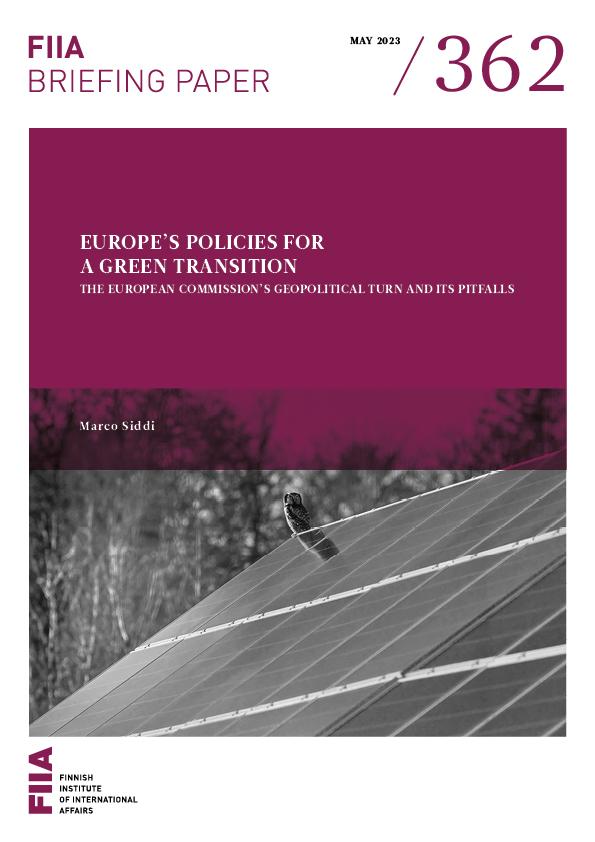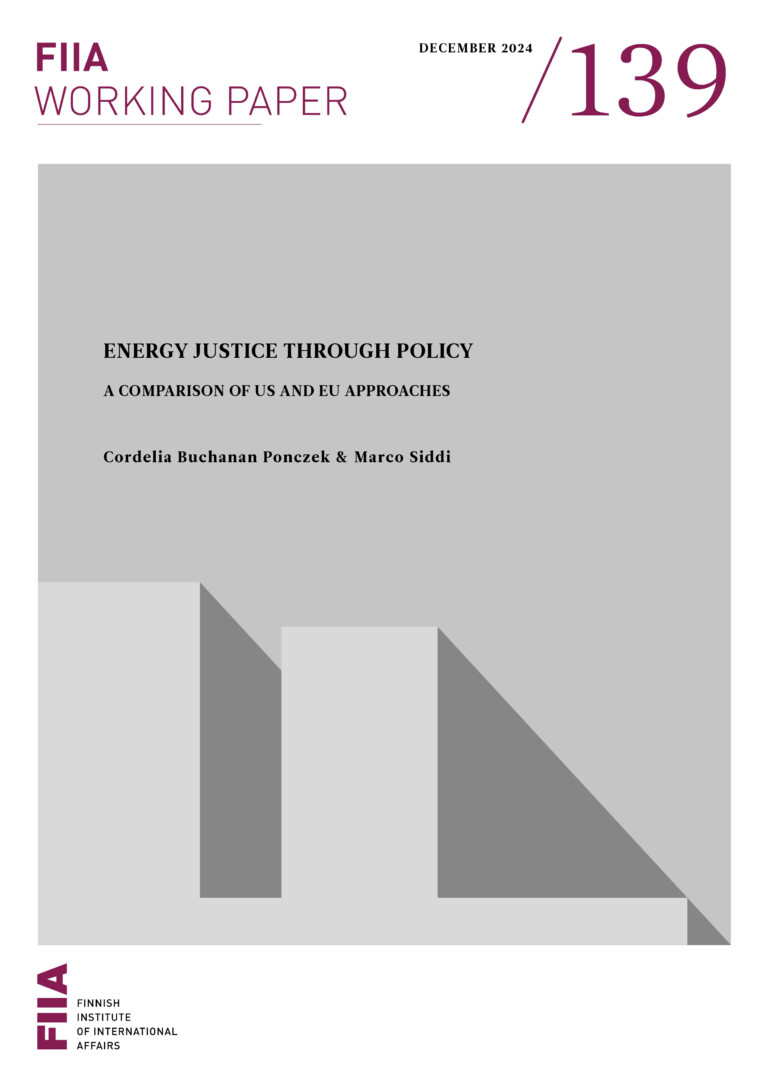Institutional reform is back on the European Union’s agenda, with the European Parliament, the Commission and large member states like Germany and France all supporting changes to the way the EU operates.
While opening the EU treaties is not without political risk and there is still no consensus on doing so among member states, this momentum for reform is unlikely to wane in the near future.
There are several reasons for the new reform drive. In particular, reforms are intended to strengthen the EU’s democratic credibility, to prevent institutional erosion in a time of permanent crisis, to make the EU more resilient to blockades by individual governments, and to lay the groundwork for the accession of new member states.
While some of the proposed changes could be achieved without treaty change, the number and variety of issues at stake entails the risk of getting bogged down in parallel debates and missing opportunities for package deals. The most efficient way to deal with the EU’s reform needs would therefore be the launch of a treaty convention.
Introduction
The train of institutional reform is gaining traction in the European Union. After more than a decade without treaty change, the past year has seen a growing dynamic to re-open the debate on how the EU is – and should be – functioning.
On 9 May 2022, the Conference on the Future of Europe – an ad-hoc body established by the EU to discuss policy priorities – adopted a wide-ranging final report containing numerous reform recommendations, some of which necessarily involve changes to the treaty framework. Subsequently, the European Parliament formally called for the launch of a convention to amend the treaties and started to prepare concrete proposals that it will present in summer 2023. The President of the European Commission, Ursula von der Leyen, expressed support for this goal in her State of the Union address in September 2022. Among the member states, a group of six governments stated in a joint non-paper in May 2022 that they were “in principle open to necessary treaty changes”.[1] In January 2023, Germany and France established a joint working group of non-governmental experts to draw up concrete reform recommendations by autumn 2023.
Other member states have been more reserved towards the idea of a treaty convention. Another joint non-paper of May 2022, signed by 13 mostly northern, central, and eastern European governments, stressed that “[w]hile we do not exclude any options at this stage, we do not support unconsidered and premature attempts to launch a process towards Treaty change”.[2] The reasons for this reluctance vary. While some governments are ideologically opposed to deeper supranational integration, others are wary of being drawn into a complicated internal reform process at a time of extraordinary geopolitical challenges. At the formal level, the European Council did not respond to the Parliament’s call and avoided taking any decision on a convention.
Nevertheless, even those countries that are sceptical about institutional reform increasingly seem to be coming to terms with the idea that at least a serious discussion about it is inevitable. This Briefing Paper analyses the roots of the new reform momentum in the EU and illustrates why it is unlikely to simply fade away in the future. Moreover, the paper maps out the main proposals that have been put forward so far and are likely to shape the upcoming debate, and argues that a proactive approach towards treaty change would be more efficient than trying to tackle institutional challenges one by one.
A changing debate
The fact that treaty reform has long been off the EU agenda was, to a large degree, due to its cumbersome procedure. According to the ordinary revision procedure (Art. 48 (2–5) of the Treaty on European Union), any member state, the European Parliament, or the Commission can submit proposals to amend the treaties. Subsequently, the European Council must decide by simple majority to launch a convention, which comprises representatives of the EU institutions as well as member states’ governments and national parliaments. The convention examines the proposals and makes recommendations to an intergovernmental conference of the member states, which then adopts the treaty amendments “by common accord”.[3] Finally, the reform has to be ratified by all member states according to their constitutional requirements, which in some cases may imply national referenda.
The challenges of this protracted unanimity-based procedure were highlighted by the failure of the Constitutional Treaty in 2004 and exacerbated by the growing number of veto players in the enlarged EU. The rise of national-populist parties and the democratic backsliding of some member states further complicated matters. As a consequence, treaty change has increasingly been seen as a high political risk for member states’ governments.
Even as several crises in the last decade revealed persistent weaknesses and inefficiencies in the EU’s institutional set-up, governments avoided a full-fledged reform. In 2011, a simplified revision procedure was used to add a single paragraph to Art. 136 of the Treaty on the Functioning of the European Union in order to facilitate the establishment of the European Stability Mechanism. In 2012, all member states except the United Kingdom and the Czech Republic (which joined later) signed the so-called fiscal compact, but never complied with its clause to take “the necessary steps [to incorporate] the substance of this Treaty into the legal framework of the European Union” within five years.[4] The prevailing mood was that a convention was a ‘Pandora’s box’, and that even if certain treaty reforms might be beneficial for the functioning of the EU, it was just not the right time to initiate them.
Recent developments, however, have called into question the relevance of this cautionary argument. While treaty change remains a complicated undertaking, the urge for institutional reforms has grown over time and may have reached a point where the political risk of engaging in a convention is smaller than the risk of maintaining the status quo. As will be discussed below, this increased reform need is not due to a single cause, but rather to several, partly interrelated factors. Among the driving motives are the need to strengthen the EU’s democratic credibility, to prevent institutional erosion, to increase the EU’s resilience to blockades and blackmail in crisis situations, and to lay the groundwork for the accession of new member states.
Strengthening democratic credibility
The pursuit of more responsive, accountable, and democratic institutions has been a long-term driver of EU reform debates. The most engaged political actor in this regard is the European Parliament, which has put forward several reform ideas in recent years. Most importantly, it adopted the so-called Verhofstadt and Brok/Bresso reports in 2017, two detailed proposals for the further institutional development of the EU with or without treaty changes.[5]
Among the most notable reforms suggested in these reports are:
-
extending the right of legislative initiative from the Commission to the Parliament and the Council;
-
giving the Parliament the right to start infringement procedures before the European Court of Justice;
-
increasing the Parliament’s co-decision rights in European economic governance;
-
reducing the size of the European Commission;
-
replacing unanimity voting in the Council with qualified majority voting;
-
introducing new procedures of ‘super-qualified’ majority voting for certain other decisions (in particular, allowing treaty changes to enter into force after ratification by 80% of member states);
-
introducing the possibility of referenda at the EU level;
-
strengthening EU citizenship by giving mobile citizens the right to vote in all elections in their country of residence.
Moreover, the European Parliament advocated formal recognition of the lead candidate (‘Spitzenkandidaten’) procedure for the election of the Commission president and, in 2022, proposed a new European electoral law including an EU-wide constituency with transnational lists.
Most of these reform proposals initially met with a lukewarm response or were outright ignored by member state governments. In 2021–22, however, the Parliament’s democratization agenda received a major boost from the Conference on the Future of Europe. The Conference was co-hosted by the Parliament, the Council, and the Commission and brought together representatives of the three institutions, the member states’ national parliaments, civil society organizations and randomly selected citizens. In a participatory bottom-up process based on an open digital platform and EU-wide citizen panels, the Conference elaborated policy proposals on a wide range of issues.
On institutional reform, the final report of the Conference endorsed many of the Parliament’s ideas and in some cases even went beyond them.[6] Among other things, it proposed:
-
a more harmonized European electoral system with transnational lists;
-
the election of the Commission president “either by […] direct election […] or a lead candidate system”;
-
a general switch from unanimity procedures to qualified majority voting in the Council (the only exceptions being the admission of new member states and changes to the EU’s fundamental values and principles);
-
a right of legislative initiative for the European Parliament;
-
the possibility of an “EU-wide referendum, to be triggered by the European Parliament, in exceptional cases on matters particularly important to all European citizens”;
-
full decision-making powers of the European Parliament in budgetary matters.
While the Conference did not attract the hoped-for broad public interest, it did set a new benchmark for citizen engagement and participatory democracy at the EU level. Since all three organizing institutions had declared in advance that they would “jointly commit to listen to Europeans and to follow up on the recommendations made by [the] Conference”,[7] they are now under increased pressure to deliver. A continued failure to respond to demands for democratic reform would damage the credibility of the EU’s commitment to participatory practices and make it even more difficult to constructively involve European citizens in the future.
Preventing institutional erosion
Other developments that contribute to the increased readiness among many European leaders to address institutional reforms have been slower and more gradual in nature. Among these is a change in the perception of crises in the EU.
For several years, the prevailing view was that the EU was in a ‘polycrisis’ – an extraordinarily complicated phase of mutually reinforcing crises (such as the Euro crisis, migration crisis, rule of law crisis, Brexit, the Covid-19 pandemic, the Russian war against Ukraine, etc.), which would, however, eventually come to an end. In this situation, muddling through rather than long-term coherence was seen as the order of the day. Until conditions improved, it seemed prudent to focus on crisis management and to postpone any comprehensive reform projects.[8]
However, as new challenges continue to add to the existing ones, the European polycrisis is increasingly being seen as a ‘permacrisis’.[9] The ever more difficult geopolitical environment as well as the still incalculable social and political consequences of global climate change, among other factors, will impede a quick return to political stability. Instead, the EU is facing an era of lasting uncertainty and volatility that could even worsen in the medium term. As a result of this prolonged crisis situation, many problems of EU governance are at risk of becoming chronic and leading to a gradual erosion of integration achievements.
This risk exists not only at the policy level, where, for example, the unresolved migration crisis has led to a lasting deterioration in the freedom of travel within the Schengen area. Also at the institutional level, the permacrisis is already changing the way the EU works. In particular, as the regular EU procedures tend to be very consensus-oriented and time-consuming, the need to react quickly to unforeseen problems has resulted in a gradual turn towards more informal decision-making, diluting accountability and shifting power away from supranational to intergovernmental institutions.
Moreover, the lack of adequate crisis response frameworks has caused European decision-makers to rely excessively on special and exceptional provisions. Repeated reinterpretation – or ‘flexing’ – of treaty rules has led to accusations that the EU is overstepping its powers. Cases of political non-compliance with high-profile decisions (such as the redistribution of asylum-seekers) as well as legal attacks on the primacy of EU law (most notably, but not only, by the German and Polish constitutional courts) are multiplying and pose a serious threat to the integrity of the European legal community. Finally, the consolidation of far-right parties and the democratic backsliding in several member states, especially Hungary and Poland, is undermining the common value base of the EU.
With this outlook, the ‘Pandora’s box’ argument is turned on its head: If the crises are not going to end in the foreseeable future, the further postponing of necessary reforms will not improve the situation, but rather increase the risk of erosion. Thus, a better approach would be to tackle necessary reforms as soon as possible in order to forestall the potential disintegration and decay of the supranational constitutional order.
Increasing resilience to blockades and blackmail
Even if institutional reforms will not provide a quick fix for all the problems of the permacrisis, they can help strengthen the EU’s resilience in acute crisis situations. One outstanding issue in this regard is the EU’s vulnerability to blockades caused by individual governments trying to advance their own national agenda at the expense of other member states and of the common European interest.
The main reason for this vulnerability is the unanimity requirement in the Council for many key policy areas. The risk of veto-based blackmail already became apparent during the debt crisis in the Eurozone when the Greek government insinuated in 2015 that it might veto EU sanctions against Russia’s illegal annexation of Crimea in order to win concessions on fiscal policy. In 2020, the Polish and Hungarian governments used their veto on the EU’s multiannual financial framework in order to weaken the rule-of-law conditionality mechanism. That same year, Cyprus temporarily vetoed EU sanctions against Belarus in order to pressure EU partners to also take action against Turkey for gas drilling activities in disputed waters in the Mediterranean. In 2022 and 2023, Hungary has repeatedly used its veto to block common EU positions on foreign and security policy, including on sanctions against Russia for its attack on Ukraine.
While issuing such explicit veto threats is more common among small and mid-sized member states, large ones tend to use threats more implicitly, but no less effectively. As large states have more resources to deal with crises on their own at the national level, they tend to suffer less from a deadlocked EU. As a result, they have a credible implicit veto position, which they can use as political leverage over smaller countries.
Unanimity requirements have thus been a key factor in weakening the EU’s capability to act and in fuelling mistrust among member states. While this kind of veto-based strong-arming is not an entirely new phenomenon, growing internal polarization and conflicts over common values have made it more prominent in recent years. Moreover, since veto threats work best in situations where the EU needs to act quickly and other member states are afraid of a deadlock, the permacrisis, with its increased frequency of highly volatile situations, provides more opportunities for individual governments willing to use this tactic.
Finally, as can be seen from the examples above, member states have repeatedly threatened to block decisions they did not actually disagree with in order to obtain concessions on other, unrelated issues. Veto pressure is therefore not only limited to policies that formally require unanimity, but can impact any area of EU decision-making. In the worst case, unanimity requirements may even encourage foreign pressure, especially on smaller member states, in an attempt to use them as ‘Trojan horses’ to obstruct the EU.
In order to avoid this kind of blocking behaviour, the EU should overcome unanimity requirements in as many areas as possible – including but not limited to the Common Foreign and Security Policy. In theory, this could be realized without a treaty change through the so-called passerelle clauses, which allow switching to qualified majority voting in most policy areas. However, as will be discussed below, passerelle clauses are less flexible than the convention method, which therefore offers more opportunities for compromise among member states.
Laying the groundwork for enlargement
Finally, the Russian attack on Ukraine and the subsequent applications for EU membership by Ukraine, Moldova and Georgia also put the question of EU enlargement back on the political agenda. The member states broadly agree that it is in the geopolitical interest of the EU to facilitate the accession of the ‘associated trio’, as well as of the Western Balkan countries, within a reasonable timeframe.
However, these accessions will also make the EU more heterogeneous, and many of the inefficiencies of existing EU procedures will increase with more member states. Several governments (including Germany, France, and Spain) therefore see internal institutional reform as an indispensable precondition for ensuring that the EU can continue to function with 30, 35 or more countries – just as the EU’s Eastern enlargements of 2004–13 were preceded by major treaty reforms culminating in the Treaty of Lisbon.
Among the reforms most often mentioned in this context[10] are:
-
extending qualified majority voting in the Council, as it would be increasingly difficult to reach unanimity among all member states;
-
reducing the size of the Commission, as a college of 30 or more Commissioners would become unworkable;
-
adjusting the national seat quotas in the European Parliament, as with their current size, Ukraine would be entitled to a quota of around 55 seats, which would result in the Parliament exceeding the treaty limit of 751 seats. It is therefore necessary either to reduce the seat quotas of other member states accordingly or to increase the total number of seats. Indirectly, this also affects the broader debate on European electoral reform and transnational lists;
-
a revision of Art. 7 of the Treaty on European Union to make sure that fundamental standards of democracy and the rule of law can effectively be protected everywhere in the EU.
Moreover, the associated trio and the Western Balkan countries have a lower GDP per capita than any of the current EU member states. Even beyond the necessary post-war reconstruction of Ukraine, EU enlargement will therefore require a strengthening of the political and financial capacity of supranational institutions to manage social and economic disparities and to maintain cohesion among member states. To deal with more heterogeneous political preferences, it may also be necessary to facilitate enhanced cooperation and other forms of internal differentiation. Finally, there is a growing debate about reforming the enlargement process itself by establishing a system of ‘staged accession’.[11] Depending on the implementation of such a system, it might require changes in the treaty framework in order to facilitate the ‘partial’ participation of acceding countries in EU decision-making.
In recent months, this link between enlargement and internal reform has become the main focus of the debate on institutional change. This is partly due to the geopolitical urgency: After a decade of enlargement policy stagnation in the Western Balkans, the EU has already lost much credibility among the candidate countries. To avoid further frustration, it must now quickly put itself in a position where it will be able to absorb new members.
Moreover, the enlargement/reform nexus has become politically significant because it lends itself to a package deal among the EU member states. Many of the governments that have so far been reluctant to embrace institutional reform are very favourable towards enlargement, and vice versa. This increases the chances of a ‘grand bargain’ that would allow progress to be made on several key EU dossiers in parallel.
Conclusions: How to proceed
As has been discussed, the EU is currently facing many institutional challenges at the same time, leading to simultaneous debates that often overlap and influence each other. Among the many reform proposals, the extension of qualified majority voting in the Council has emerged as the most prominent, as it would help make the EU more democratic, more resilient, and more ready for enlargement. But reducing unanimity requirements is not the only issue at stake, and a focus on this approach alone will not suffice to address all of the EU’s reform needs.
The high number of interlinked challenges has implications for the question of how to proceed with institutional reform – in particular, whether it is really necessary to amend the EU treaties or whether changes could also be implemented within the existing framework. For example, the treaties already contain several so-called passerelle clauses that would allow switching from unanimity to qualified majority voting.[12] Similarly, a reduction in the number of Commissioners or most changes to the European electoral system could also be achieved without a treaty revision.
However, there are several factors that limit the potential of these intra-treaty reform options. First of all, all relevant reform procedures require unanimous decisions by the European Council anyway, and in many cases even parliamentary ratification at the national level. From a procedural perspective, they are therefore not much easier to achieve than full treaty reforms.
Second, intra-treaty reform procedures are usually more rigid and provide less room for compromises than a treaty change. For example, the existing passerelle clauses only allow switching from unanimity to regular qualified majority voting – keeping other options like a ‘super-qualified’ majority vote that would require the consensus of 75% or 80% of the member states off the table.
Finally, focusing only on the limited number of reforms that are possible within the treaty could lead to missed opportunities for package deals and ‘grand bargains’. Given the large number of interlinked challenges, trying to tackle institutional issues one by one entails the risk of getting bogged down in endless parallel discussions. This is especially problematic for small and mid-sized member states with limited national administrative capacity to invest in institutional debates.
Instead, the most efficient approach to dealing with reforms would be to proactively create a setting that allows debates to be bundled and cross-cutting compromises to be reached. The logical place for this is a treaty convention as proposed by the European Parliament. The European Council would be well-advised to agree as soon as possible to call such a convention, which could then start its work after the 2024 European elections.
Endnotes
[1] Non-paper submitted by Germany, Belgium, Italy, Luxembourg, the Netherlands, and Spain on implementing the proposals of the Plenary of the “Conference on the Future of Europe”, 13 May 2022. https://www.tweedekamer.nl/kamerstukken/detail?id=2022D20911&did=2022D20911.
[2] Non-paper by Bulgaria, Croatia, the Czech Republic, Denmark, Estonia, Finland, Latvia, Lithuania, Malta, Poland, Romania, Slovenia, and Sweden on the outcome of and follow-up to the Conference on the Future of Europe, 9 May 2022.
[3] Art. 48 (4) of the Treaty on European Union.
[4] Art. 16 of the Treaty on Stability, Coordination and Governance in the Economic and Monetary Union.
[5] European Parliament, Resolution on possible evolutions of and adjustments to the current institutional set-up of the European Union (2014/2248(INI)), 16 February 2017, based on a report by Guy Verhofstadt (ALDE, Belgium). https://www.europarl.europa.eu/doceo/document/TA-8-2017-0048_EN.html; European Parliament, Resolution on improving the functioning of the European Union building on the potential of the Lisbon Treaty (2014/2249(INI)), 16 February 2017, based on a report by Elmar Brok (EPP, Germany) and Mercedes Bresso (S&D, Italy). https://www.europarl.europa.eu/doceo/document/TA-8-2017-0049_EN.html.
[6] Conference on the Future of Europe: Report on the final outcome, 9 May 2022. https://prod-cofe-platform.s3.eu-central-1.amazonaws.com/qtde64rjnkdaf5u2j54ocssxyn9w.
[7] Joint Declaration of the European Parliament, the Council and the European Commission on the Conference on the Future of Europe: Engaging with citizens for democracy – Building a more resilient Europe (2021/C 91 I/01), 10 March 2021. https://eur-lex.europa.eu/legal-content/EN/TXT/?uri=CELEX%3A32021C0318%2801%29.
[8] Zeitlin Jonathan, Francesco Nicoli and Brigid Laffan (2019) Introduction: The European Union beyond the polycrisis? Integration and politicization in an age of shifting cleavages. Journal of European Public Policy 26 (7), 2019, 963–976, DOI: 10.1080/13501763.2019.1619803.
[9] Zuleeg Fabian, Janis A. Emmanouilidis and Ricardo Borges de Castro (2021) Europe in the age of permacrisis. European Policy Centre, 11 March 2021. https://www.epc.eu/en/Publications/Europe-in-the-age-of-permacrisis~3c8a0c.
[10] See, e.g., von Ondarza Nicolai (2022) “Ukrainian accession also requires reform of EU institutions”, in Ukraine’s possible EU accession and its consequences (360 Degrees), coordinated by Nicolai von Ondarza. German Institute for International and Security Affairs (SWP), 22 July 2022. https://www.swp-berlin.org/en/publication/ukraines-possible-eu-accession-and-its-consequences.
[11] Emerson Michael, Milena Lazarević, Steven Blockmans and Strahinja Subotić (2021) A Template for Staged Accession to the EU. European Policy Centre (CEP) / Centre for European Policy Studies (CEPS), 1 October 2021. https://www.ceps.eu/ceps-publications/a-template-for-staged-accession-to-the-eu/.
[12] Cf. Mintel Julina and Nicolai von Ondarza (2022) More EU Decisions by Qualified Majority Voting – but How? Legal and political options for extending qualified majority voting. SWP Comment 2022/C 61, 19 October 2022. https://www.swp-berlin.org/10.18449/2022C61/.














